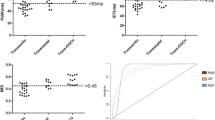Abstract
In activation mapping of reentrant atrial tachycardia (AT), there was no reference for window of interest (WOI). We examined the timing of a successful termination site from end of the P wave and attempted to determine whether the critical isthmus can be identified using activation mapping when WOI was set as end to end of the P wave. Forty patients with 54 reentrant AT who underwent 3D electroanatomic mapping and radiofrequency catheter ablation were evaluated retrospectively. The critical isthmus was defined as a successful termination site. We evaluate critical isthmus timing from end of the P wave and percentage of critical isthmus timing from end of the P wave to tachycardia cycle length. In 54 reentrant AT, Macro-reentry was identified in 46 (85.2%) and micro-reentry was identified in eight (14.8%). The timing of the critical isthmus site from end of the P wave was − 4.0 ± 31.1 ms (Macro-reentry vs. Micro-reentry; − 8.9 ± 29.4 ms vs. 24.0 ± 26.7 ms; P = 0.005). The percentage of critical isthmus timing from end of the P wave/tachycardia cycle length was − 1.4 ± 10.5% (Macro-reentry vs. Micro-reentry; − 3.1 ± 9.8% vs. 8.3 ± 9.3%, P = 0.004) The critical isthmus of reentrant AT is located within 10% backward and forward from end of the P wave to tachycardia cycle length. Setting the WOI from end to end of the P wave is useful for identification of the critical isthmus through activation mapping.






Similar content being viewed by others
Data availability
The data underlying this article will be shared on reasonable request to the corresponding author.
Change history
19 January 2024
A Correction to this paper has been published: https://doi.org/10.1007/s00380-024-02357-x
References
Patel AM, d’Avila A, Neuzil P, Kim SJ, Mela T, Singh JP, Ruskin JN, Reddy VY (2008) Atrial tachycardia after ablation of persistent atrial fibrillation: identification of the critical isthmus with a combination of multielectrode activation mapping and targeted entrainment mapping. Circ Arrhythm Electrophysiol 1(1):14–22
Jais P, Shah DC, Haissaguerre M, Hocini M, Peng JT, Takahashi A, Garrigue S, Le Metayer P, Clementy J (2000) Mapping and ablation of left atrial flutters. Circulation 101(25):2928–2934
Ouyang F, Ernst S, Vogtmann T, Goya M, Volkmer M, Schaumann A, Bansch D, Antz M, Kuck KH (2002) Characterization of reentrant circuits in left atrial macroreentrant tachycardia: critical isthmus block can prevent atrial tachycardia recurrence. Circulation 105(16):1934–1942
Anter E, Duytschaever M, Shen C, Strisciuglio T, Leshem E, Contreras-Valdes FM, Waks JW, Zimetbaum PJ, Kumar K, Spector PS, Lee A, Gerstenfeld EP, Nakar E, Bar-Tal M, Buxton AE (2018) Activation mapping with integration of vector and velocity information improves the ability to identify the mechanism and location of complex scar-related atrial tachycardias. Circ Arrhythm Electrophysiol 11(8):e006536
Mechulan A, Bun SS, Masse A, Peret A, Leong-Feng L, Pons F, Bouharaoua A, Dieuzaide P, Prevot S (2022) An improved window of interest for electroanatomical mapping of atrial tachycardia. J Interv Card Electrophysiol 63(1):29–37
De Ponti R, Verlato R, Bertaglia E, Del Greco M, Fusco A, Bottoni N, Drago F, Sciarra L, Ometto R, Mantovan R, Salerno-Uriarte JA (2007) Treatment of macro-re-entrant atrial tachycardia based on electroanatomic mapping: identification and ablation of the mid-diastolic isthmus. Europace 9(7):449–457
Rav-Acha M, Ng CY, Heist EK, Rozen G, Chalhoub F, Kostis WJ, Ruskin J, Mansour M (2016) A novel annotation technique during mapping to facilitate the termination of atrial tachycardia following ablation for atrial fibrillation. J Cardiovasc Electrophysiol 27(11):1274–1281
Magnin-Poull I, De Chillou C, Miljoen H, Andronache M, Aliot E (2005) Mechanisms of right atrial tachycardia occurring late after surgical closure of atrial septal defects. J Cardiovasc Electrophysiol 16(7):681–687
Stevenson IH, Kistler PM, Spence SJ, Vohra JK, Sparks PB, Morton JB, Kalman JM (2005) Scar-related right atrial macroreentrant tachycardia in patients without prior atrial surgery: electroanatomic characterization and ablation outcome. Heart Rhythm 2(6):594–601
Brunckhorst CB, Delacretaz E, Soejima K, Maisel WH, Friedman PL, Stevenson WG (2004) Identification of the ventricular tachycardia isthmus after infarction by pace mapping. Circulation 110(6):652–659
Stevenson WG, Sager PT, Natterson PD, Saxon LA, Middlekauff HR, Wiener I (1995) Relation of pace mapping QRS configuration and conduction delay to ventricular tachycardia reentry circuits in human infarct scars. J Am Coll Cardiol 26(2):481–488
Bun SS, Latcu DG, Marchlinski F, Saoudi N (2015) Atrial flutter: more than just one of a kind. Eur Heart J 36(35):2356–2363
Takigawa M, Martin CA, Derval N, Denis A, Vlachos K, Kitamura T, Frontera A, Martin R, Cheniti G, Lam A, Bourier F, Thompson N, Wolf M, Massoulie G, Escande W, Andre C, Zeng LJ, Nakatani Y, Roux JR, Duchateau J, Pambrun T, Sacher F, Cochet H, Hocini M, Haissaguerre M, Jais P (2019) Insights from atrial surface activation throughout atrial tachycardia cycle length: a new mapping tool. Heart Rhythm 16(11):1652–1660
Acknowledgements
None.
Funding
No specific grant from funding agencies in the public, commercial, or not-for-profit sectors was received for conduct of this research.
Author information
Authors and Affiliations
Corresponding author
Ethics declarations
Conflict of interest
None declared.
Additional information
Publisher's Note
Springer Nature remains neutral with regard to jurisdictional claims in published maps and institutional affiliations.
Supplementary Information
Below is the link to the electronic supplementary material.
Rights and permissions
Springer Nature or its licensor (e.g. a society or other partner) holds exclusive rights to this article under a publishing agreement with the author(s) or other rightsholder(s); author self-archiving of the accepted manuscript version of this article is solely governed by the terms of such publishing agreement and applicable law.
About this article
Cite this article
Choi, JH., Kwon, C.H. Timing of critical isthmus from end of P wave and usefulness of activation mapping with window of interest from end to end of P wave in reentrant atrial tachycardia. Heart Vessels 39, 319–327 (2024). https://doi.org/10.1007/s00380-023-02335-9
Received:
Accepted:
Published:
Issue Date:
DOI: https://doi.org/10.1007/s00380-023-02335-9




